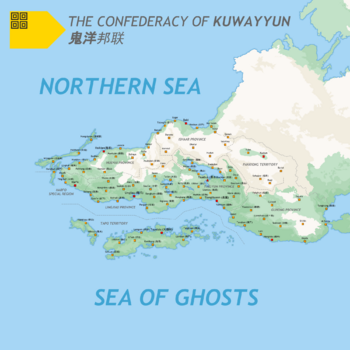Kuwayyun: Difference between revisions
Cutegirlpoop (talk | contribs) No edit summary |
Cutegirlpoop (talk | contribs) No edit summary |
||
| Line 104: | Line 104: | ||
The country is multiethnic and multicultural, which has a significant effect on its politics. A little over 40% of the population is ethnically {{wp|Hoklo people|Banlongese}}, making up a plurality as the largest single ethnic group within the country. The second largest ethnic group are the {{wp|Somalis|Sawami}} people, followed by the {{wp|Cantonese people|Yuet}}, {{wp|Arabs|Daryabi}}, and {{wp|Hakka people|Khehkanese}}. The country's official language is {{wp|Hokkien|Banlongese}}, whilst {{wp|Somali language|Sawami}} remains an active second language. | The country is multiethnic and multicultural, which has a significant effect on its politics. A little over 40% of the population is ethnically {{wp|Hoklo people|Banlongese}}, making up a plurality as the largest single ethnic group within the country. The second largest ethnic group are the {{wp|Somalis|Sawami}} people, followed by the {{wp|Cantonese people|Yuet}}, {{wp|Arabs|Daryabi}}, and {{wp|Hakka people|Khehkanese}}. The country's official language is {{wp|Hokkien|Banlongese}}, whilst {{wp|Somali language|Sawami}} remains an active second language. | ||
== Etymology == | |||
Kweihunyang is derived from the name of the sea to the south of the country. The Banlongese communities of the east coast of [[Tung Wan]] had long observed the phenomenon known as [[kwei baksai|kweí ba̍k-sái]] (Banglongese: 鬼目屎, ghost tears) – pale, white, teardrop shaped petals which would wash ashore in the typhoon season. Whilst they were most certainly composed of vegetation, and not the tears of ghosts as oral tradition would state, they did not appear to match any known flowers native to the region. Washing ashore from the eastern ocean, these petals gave rise to the idea of a land far across the [[Sea of Ghosts]] (Banlongese: 鬼魂洋, kweí hûn iûnn), the name by which the eastern ocean would come to be called. Today, these petals are known to belong to the [[Kweihunyang White Hibiscus]], native to the tropical rainforests of the southwestern coasts of Daghreb, and the national flower of Kweihunyang. | |||
[[Category:Countries]] | [[Category:Countries]] | ||
Revision as of 03:13, 27 November 2022
Confederacy of Kweihunyang 鬼魂洋 | |
|---|---|
| Motto: 有實力或滅亡 (Banlongese) "Have strength or perish" | |
| Anthem: Kweihunyang Prevails | |
 Map of Kweihunyang | |
| Capital | Tsuabun |
| Largest city | Lingjiau |
| Official languages | Banlongese, Sawami |
| Recognised national languages | Tungwanese |
| Recognised regional languages | Daryabi |
| Ethnic groups (2018) | 41.4% Banlongese, 36.1% Sawami, 11.7% Yuet, 7.3% Daryabi, 3.2% Khehkanese 3.1% other |
| Demonym(s) | Kweiyangese |
| Government | Federal parliamentary constitutional elective monarchy |
• Premier | Tan Tsunkiat |
• Emperor | Taitsu |
| Legislature | Parliament of Kweihunyang |
| Royal Assembly | |
| Consultative Assembly | |
| Formation | |
• Confederacy established | 1794 |
| Population | |
• 2020 estimate | |
| GDP (PPP) | 2022 estimate |
• Total | |
• Per capita | |
| GDP (nominal) | 2022 estimate |
• Total | |
• Per capita | |
| Gini (2020) | medium |
| HDI (2020) | very high |
| Currency | Kweiyangese guan (₲) |
| ISO 3166 code | KY |
| Internet TLD | .ky |
Kweihunyang (鬼魂洋), officially the Confederacy of Kweihunyang, is a country in western Daghreb. The federal constitutional monarchy consists of five provinces, three federal territories, and one special region. Kweihunyang is separated by the Lingtsiah Mountains into two regions, the largely tropical, southerly region of Likkong, and the largely arid, northerly region of Suakong. Kweihunyang borders Alqana to the northeast and Suhal to the east. Tsuabun is Kweihunyang's capital and its second most populous city, whilst Lingjiau City is its most populous.
The country is multiethnic and multicultural, which has a significant effect on its politics. A little over 40% of the population is ethnically Banlongese, making up a plurality as the largest single ethnic group within the country. The second largest ethnic group are the Sawami people, followed by the Yuet, Daryabi, and Khehkanese. The country's official language is Banlongese, whilst Sawami remains an active second language.
Etymology
Kweihunyang is derived from the name of the sea to the south of the country. The Banlongese communities of the east coast of Tung Wan had long observed the phenomenon known as kweí ba̍k-sái (Banglongese: 鬼目屎, ghost tears) – pale, white, teardrop shaped petals which would wash ashore in the typhoon season. Whilst they were most certainly composed of vegetation, and not the tears of ghosts as oral tradition would state, they did not appear to match any known flowers native to the region. Washing ashore from the eastern ocean, these petals gave rise to the idea of a land far across the Sea of Ghosts (Banlongese: 鬼魂洋, kweí hûn iûnn), the name by which the eastern ocean would come to be called. Today, these petals are known to belong to the Kweihunyang White Hibiscus, native to the tropical rainforests of the southwestern coasts of Daghreb, and the national flower of Kweihunyang.

